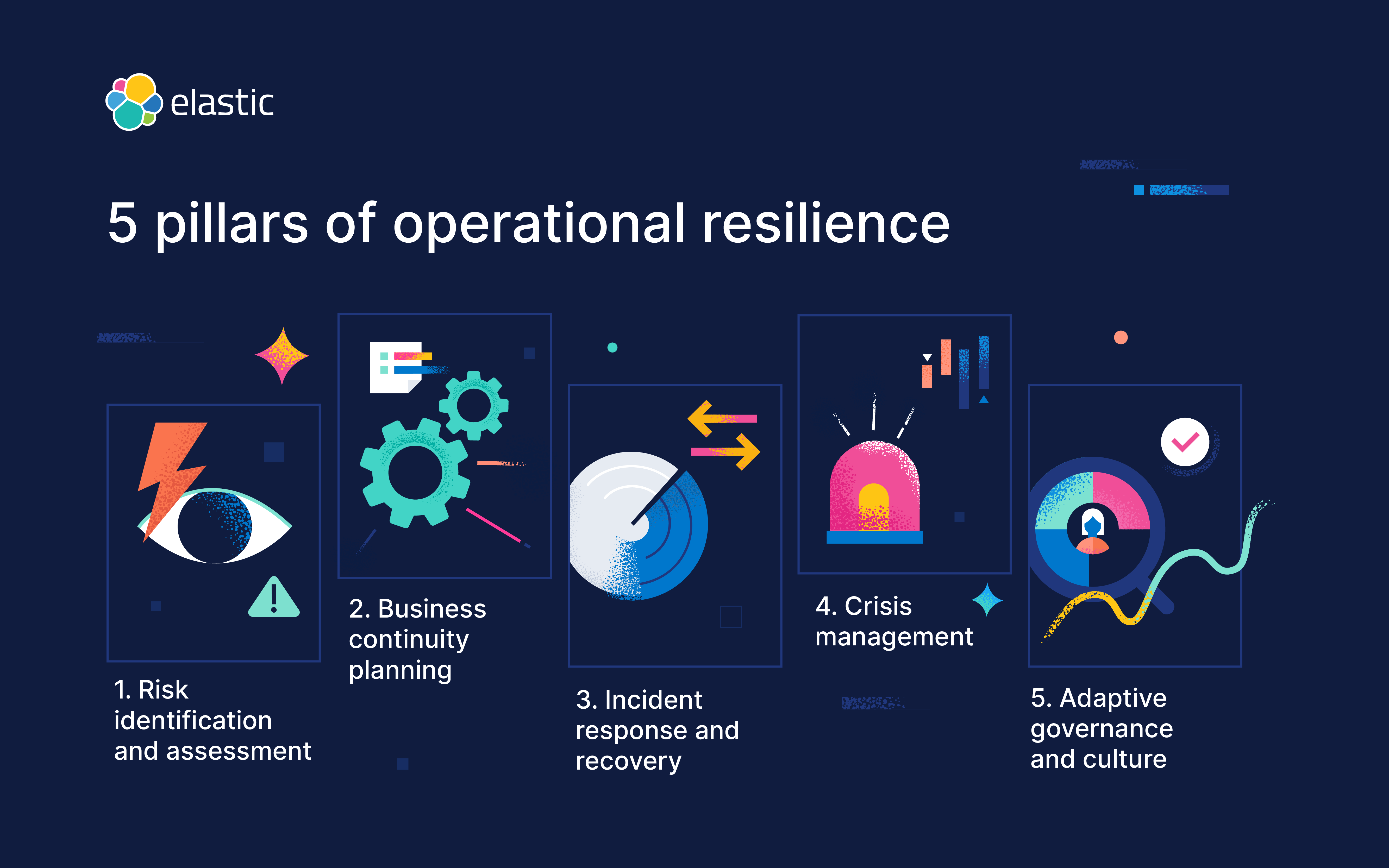5 pillars of operational resilience

What is operational resilience?
No organization is immune to disruptions. Whether it’s a flawed update, a targeted cyber attack, or even a global pandemic responsible for a massive supply chain upheaval, most companies will, at some point, hit a speed bump. That’s the price of growth. But successful companies know how to respond, recover, and learn from disruptions with the help of a sound operational resilience framework.
Operational resilience is the ability to respond, recover, and resume operations in the face of such disruptions.
On the other hand, a lack of preparation and an inadequate response can lead to reputational, legal, and financial consequences. Worst case, it can shutter a business for good. Operational resilience can be the deciding factor between going out of business and experiencing exponential growth. It all depends on efficient top-down planning, a commitment to adaptive governance and culture, and actionable insights.
This is where observability comes into play. Observability offers a holistic view of local and external dependencies in a single pane of glass. It’s crucial for predicting failures and running smooth operations in a digital world even when you’re not in crisis mode. The ability to monitor systems and to see the connecting elements across verticals can make the difference between a quick recovery or tens of thousands of dollars lost in revenue.
However, operational resilience goes beyond observability. Combined with cybersecurity practices, operational resilience planning and implementation ensure that your systems are up and running while you maintain a proactive security posture. A resilient mindset invites organizations to take a proactive stance toward threats to ensure that all critical functions remain operational, no matter the circumstances. At its core, operational resilience is about safeguarding the entire ecosystem of an organization so that it can withstand shocks, maintain its key functions, and thrive.
Pillars of operational resilience
Operational resilience is a multi-part framework that requires a concerted coordination effort between organizational leaders, their partners, and dependents. It begins with understanding the web of dependencies — from code to supply chain — in any operational context and ends with a continuous review and refinement of protocols.

A comprehensive operational resilience framework comes down to five key pillars:
Risk identification and assessment
Business continuity planning
Incident response and recovery
Crisis management
Adaptive governance and culture
1. Risk identification and assessment
Risk identification and assessment involves identifying, assessing, and mitigating risks that could impact an organization's ability to function. By leveraging AI and machine learning (ML) technologies, organizations can proactively identify and classify potential risks. Anticipating (and resolving) problems before they come is key to building a comprehensive business continuity plan, which in turn directly impacts an organization’s resilience.
This pillar of operational resilience includes the mapping of interconnections and interdependencies. Organizations exist within a web of interconnections and a network of interdependencies from distributed architectures to third-party reliance and global economic currents. While this may be the product of a technologically connected world, mapping these interconnections and interdependencies is vital to identifying potential failure points and achieving operational resilience.
Most businesses rely on third-party vendors and partners for critical services, making third-party dependency management essential for risk identification and assessment. An incident in a third-party service that results in a disruption on their end will inevitably affect your organization. Operational resilience depends on establishing clear processes like backup services and containment protocols.
2. Business continuity planning
Business continuity planning — the steps an organization and its people must take in the event of a crisis — focuses on internal processes and lays out identification and assessment methodologies and solutions to potential disruptions. As the technological landscape evolves and different risks develop, continuous testing of the continuity plan is crucial.
For example, a global manufacturing company might conduct regular disaster recovery drills to simulate various disruption scenarios, such as supply chain breakdowns or IT failures. These drills help the company refine its business continuity plans, ensuring it can maintain production and delivery schedules even during crises.
3. Incident response and recovery
Incident response and recovery is the process of identifying, responding to, and recovering from unplanned events or incidents. Incidents vary in size and scope — from hardware and connectivity issues to network errors and cyber attacks. Incident management covers a variety of potentially disruptive events. Successful incident response and recovery require speed, flexibility, and clear channels of communication. Done well, incident management allows operations to continue during response with minimal to no disruptions — the key to that? Planning.
An incident response and recovery plan details who does what in the case of any given incident. It identifies stakeholders, expected resolution timelines, and escalation and documentation protocols. When an incident occurs, IT teams will work to identify, log, and classify it and then contain the issue and diagnose it and finally, resolve and review it.
Observability and security monitoring play an important role in this process, helping determine the root cause of any red flag. Providing complete visibility into your systems, observability tools help teams patch and resolve issues without interrupting services altogether.
4. Crisis management
Crisis management ensures that an organization can continue to function and deliver critical services during disruptive events like unplanned downtime or cyber attacks. This involves proactive preparation, identifying potential risks, and developing plans to mitigate them. A crisis response framework is key, outlining roles, responsibilities, and communication channels to coordinate a swift response. Business continuity planning (BCP) plays a vital role by ensuring that essential functions continue despite disruptions.
Not only is the technological response important, but a strong communication strategy is also essential in crisis management. It keeps staff aligned and manages stakeholder expectations during disruptions. Once the crisis subsides, the focus shifts to recovery, restoring normal operations quickly and efficiently. This stage also offers an opportunity to analyze the crisis response and adapt strategies to improve future resilience. Effective crisis management ensures that organizations not only withstand disruptions but also become stronger and more adaptable for future challenges.
5. Adaptive governance and culture
Organizations build adaptive governance and culture by investing in leadership and resources that promote active learning from incidents, helping to better prepare for future disruptions. This includes fostering a culture that encourages transparency, continuous improvement, and collaboration across teams.
By embedding resilience into decision-making processes and their overall culture, organizations can swiftly adapt to changing circumstances, leverage feedback from past incidents, and implement flexible strategies that evolve with emerging risks. Adaptive governance ensures that resilience isn't just a reactive measure but a proactive approach, enabling organizations to respond dynamically to challenges while maintaining operational stability.
Related article: How to achieve operational resilience with the right data store
Operational resilience best practices
Achieving operational resilience isn’t straightforward. It looks different for every organization. Differences aside, these best practices apply across the board:
Identify essential operations: Determine which operations are critical to your organization's success and must be prioritized during a disruption. This focus lets you allocate resources effectively, so the most important functions remain operational.
Ensure leadership commitment: Operational resilience is a product of leadership and culture. Leadership buy-in is crucial for fostering a culture of resilience and securing the resources needed to implement effective strategies.
Establish feedback loops: Operational resilience requires a growth mindset from everyone within the organization. By creating feedback loops to learn from past disruptions, you can continuously improve resilience strategies.
Perform regular audits: Conduct regular audits to ensure compliance with regulations and industry standards. These audits help identify gaps in your resilience strategies and ensure your organization is prepared for future challenges.
Use cloud-based services: Leverage cloud-based services for data storage and applications, as they offer flexibility and scalability during disruptions.
Develop a comprehensive business continuity plan: Create a comprehensive BCP that outlines procedures for maintaining operations during a disruption. Ensure that your BCP is regularly tested and updated to reflect changes in your organization or the external environment.
And just like that, you’re one step closer to operational resilience.
Achieve operational resilience with Elastic
Your business runs on data. Putting that data to work with actionable insights starts with implementing search, observability, and security solutions that work together seamlessly. Finding answers quickly, using all of your data wherever it lives and connecting workflows lead to fewer blindspots, more efficient incident resolution, and ultimately, operational resilience.
Additional operational resilience resources
- A comprehensive guide to operational resilience
- Improve operational resilience with generative AI
- Achieve operational resilience with a flexible data store
- Boost operational resilience and IT efficiency in financial services
- Elastic in action: Operational resilience in public sector
- Improve operational resilience by solving your hidden data challenges
The release and timing of any features or functionality described in this post remain at Elastic's sole discretion. Any features or functionality not currently available may not be delivered on time or at all.


